New Items
Canon 24-70 f/4 IS Resolution Tests
A lot of people have been waiting on the release of the Canon 24-70 f/4 IS, deciding which of the new lenses they wanted, or whether they wanted to upgrade at all. So, when the first batch arrived early this morning we were set up and waiting to do some resolution testing.
The Players
The Canon 24-70 f/4 IS fits in the ‘standard zoom’ lens category which is fairly crowded. The new Canon 24-70 f/2.8 Mk II and Tamron 24-70 f/2.8 VC lenses are already out. The Canon 24-70 f/2.8 Mk I is no longer produced but is in a lot of photographers’ bags already. The Canon 24-105 f/4 IS already offers an f/4 image stabilized zoom with a greater range. It’s a lot to choose from and the new lens is going to have to be impressive to sell well at its higher price.
Let’s take a look at how this group prices out (these are today’s retail prices, but I expect you can get $100 or so off each of them fairly soon).
Lens Price
Canon 24-70 f/2.8 Mk II $2,199
Canon 24-70 f/4 IS $1,499
Tamron 24-70 f/2.8 VC $1299
Canon 24-105 f/4 IS $1,091
We’ve previously compared the Mk and Mk II Canons in depth, and compared them to the Tamron f/2.8 VC. A couple of conclusions are already apparent:
- If you want the best 24-70 f/2.8 zoom at any price, the Canon 24-70mm f/2.8 Mk II outresolves anything else, period.
- If you want image stabilization with your 24-70 zoom, the Tamron is really very good, and while it doesn’t quite resolve up to Mk II standards, it does outresolve the Mk I version (which is itself a pretty good lens, at least when you get a good copy).
- The Canon 24-105 f/4 IS gives good quality and greater range at a lower price.
I try to identify my expectations going into an evaluation. In this case, given the price, the 24-70 f/4 IS will need to be a better lens than the Canon 24-105 and at least as good as the Tamron at f/4 to justify its price. I’ll go further and say it should be better than the Canon 24-70 f/2.8 Mk I at f/4 as well. Anything less would be a failure.
The Usual Disclaimer
This isn’t a lens review. I am not a reviewer. I don’t spend days evaluating a single copy of a lens for all of its traits and characteristics, nor do I take hundreds of really great photos with it and describe how it works in the field. Several of the lenses I tested today are on the way to people who will do just that and their thorough reviews will be available in a week or so.
What I do is test multiple copies of the lens for resolution and other basic stuff. Multiple copies lets us take sample variation into account to some degree, which a thorough review of a single lens can’t.
A Quick Comparison
Compared to the Canon and Tamron 24-70 f/2.8 lenses, the new one is a bit smaller at 3.7″ long, 1.32 pounds, with a 77mm front filter ring.
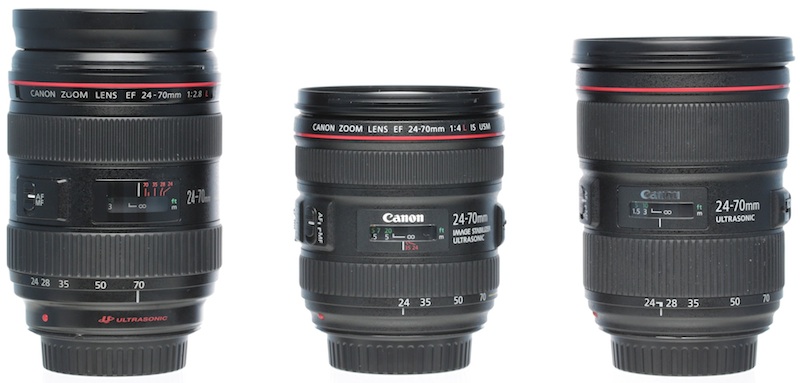
- Left to right Canon 24-70 f/2.8 Mk I, 24-70 f/4 IS, 24-70 f/2.8 Mk II
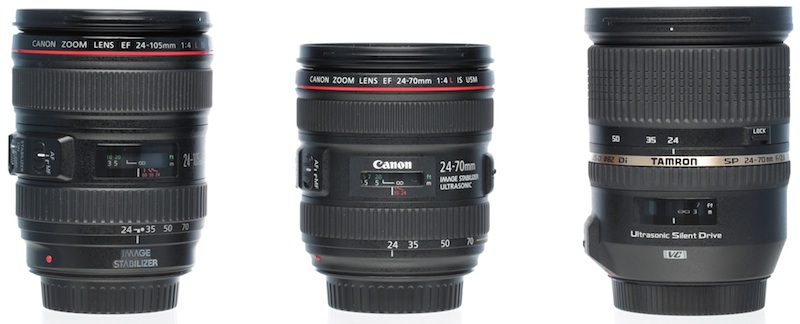
- Left to right: Canon 24-105 f/4 IS, Canon 24-70 f/4 IS, Tamron 24-70 f/2.8 VC
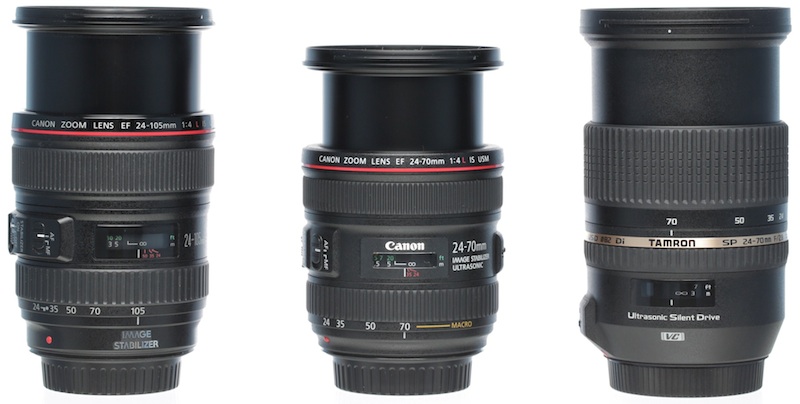
- And with barrels extended
It’s also significantly shorter than the 24-105 f/4 IS – although they actually look quite alike. I’ll add that I really, really, really like the pinch cap on the new lens, which makes it easy to remove the cap even with the hood mounted.
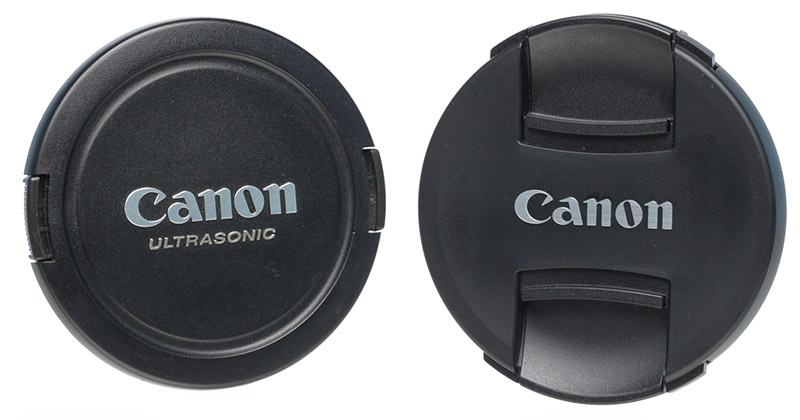
Macro Mode
Not really part of our usual testing here, but the 24-70 f/4 IS has a special switch that allows it to become a near macro (0.7x) at the expense of losing infinity focus. While I usually think of ‘macro zoom’ as a marketing gimmick (and I’m still not sure about this one), Canon did put their Hybrid IS unit in this lens, just like the one in the Canon 100mm f/2.8 IS L macro lens, so I’ll give this one the benefit of the doubt.

- Macro with 100mm f/2.8 IS L (center 50% of image, resized)

- Macro mode with 24-70 f/4 IS (center 50% of image, resized)
I find the macro mode and small size nice differentiators that may make this lens a good choice for some photographers if the optics are excellent. I should mention, though, that the macro working distance is quite short — about 2 inches from the front element. Getting it into macro mode is a bit clumsy as you have to hold the switch while rotating the zoom ring. But it’s a nice feature.
Resolution Results
We tested 22 copies of the Canon 24-70 f/4 IS L at 24mm and 70mm using our Imatest lab. We had numbers from testing 100+ copies of the 24-105 f/4 IS already available. We had recently tested all of our 24-70 Mk I, Mk II and Tamron 24-70 f/2.8 VC lenses, but only at f/2.8, so we repeated those tests on 10 known good copies of each at f/4 so we would be able to compare how all the lenses performed at f/4. There was not time to test everything at f/5.6.
Results at f/2.8
The f/2.8 numbers are posted elsewhere, but I’ll repeat them here. If you’re going to pay more money for an f/2.8 lens, but mostly will shoot at f/4, it’s worthwhile knowing how much resolution you give up at f/2.8. The numbers are Imatest MTF50 values at the cener, averaged at 13 points over the entire lens, and the average of the 4 corner numbers.
Lens focal length CenterMTF50 AverageMTF50 Avg. CornerMTF50
Canon 24-70 f/2.8 Mk I 70mm 710 580 360
Canon 24-70 f/2.8 Mk II 70mm 940 810 480
Tamron 24-70 f2.8 VC 70mm 740 660 420
Canon 24-70 f/2.8 Mk I 24mm 730 610 380
Canon 24-70 f/2.8 Mk II 24mm 950 820 510
Tamron 24-70 f2.8 VC 24mm 815 765 430
The three 24-70 f/2.8 zoons are all good lenses, but it’s obvious from a resolution standpoint the Canon Mk II is the best and the Tamron between the Mk I and Mk II results.
Results at f/4
We have 5 lenses to compare at f/4 and I’ve added corner resolution, distortion, and chromatic aberration numberes. To keep all that data organized I’l make separate tables for results at 24mm and 70mm.
We’ll look at 24mm first.
Lens CenterMTF50 AverageMTF50 AvgCornerMTF50 Barrel Dist. CA%
Canon 24-70 f/2.8 Mk I 860 735 470 2.0% .05%
Canon 24-70 f/2.8 Mk II 1010 910 615 2.1% .05%
Tamron 24-70 f/2.8 VC 940 815 500 2.8% .04%
Canon 24-70 f/4 IS 950 825 560 1.7% .05
Canon 24-105 f/4 IS 890 730 480 5% .06%
The f/2.8 lenses, which are all good at f/2.8, sharpen up even further when stopped down to f/4. The Canon 24-105 f/4 IS accounts itself well here, resolving just as well as the original Canon 24-70 f/2.8 lens, although it does show more barrel distortion than the others. The new 24-70 f/4 IS isn’t quite what I’d hoped (I was hoping it would match the Mk II f/2.8 lens at f/4), but it’s better than the 24-105 or the original 24-70 f/2.8. It’s probably a bit better in the far corners than the Tamron 24-70 f/2.8 VC, but otherwise they’re about dead even.
One thing that is very good on the new lens is the lower barrel distortion, just under 2%. This probably is most noticeable when compared to the 24-105 f/4 IS, which has pretty bad barrel distortion right at 24mm.
Here is the same data when the lenses are shot lenses at 70mm
Lens Center MNTF50 AverageMTF50 Avg.CornerMTF50 Pinc. Dist. CA%
Canon 24-70 f/2.8 Mk I 805 645 430 1.3% .04%
Canon 24-70 f/2.8 Mk II 975 820 580 1.4% .05%
Tamron 24-70 f/2.8 VC 890 735 510 1.5% .04%
Canon 24-70 f/4 IS 920 750 525 1% .05
Canon 24-105 f/4 IS 840 680 470 1.2% .05%
None of the f/2.8 zooms are quite as sharp at 70mm as they were at 24mm, but the difference is pretty minimal. The 24-105 f/4 IS still does quite well, perhaps a bit better than the original 24-70, although that’s splitting hairs. It should be mentioned, though, that the 24-105 starts to get a tiny bit softer after 80mm – at 70mm we’re in its sweet spot.
The new 24-70 f/4 IS stays in proportion — it’s about the same as the Tamron, not as good as the Canon 24-70 f/2.8 Mk II, but better than the original Canon 24-70 and the 24-105 f/4 IS.
Sample Variation
I’ve graphed the center and average resolution for all 22 copies below.
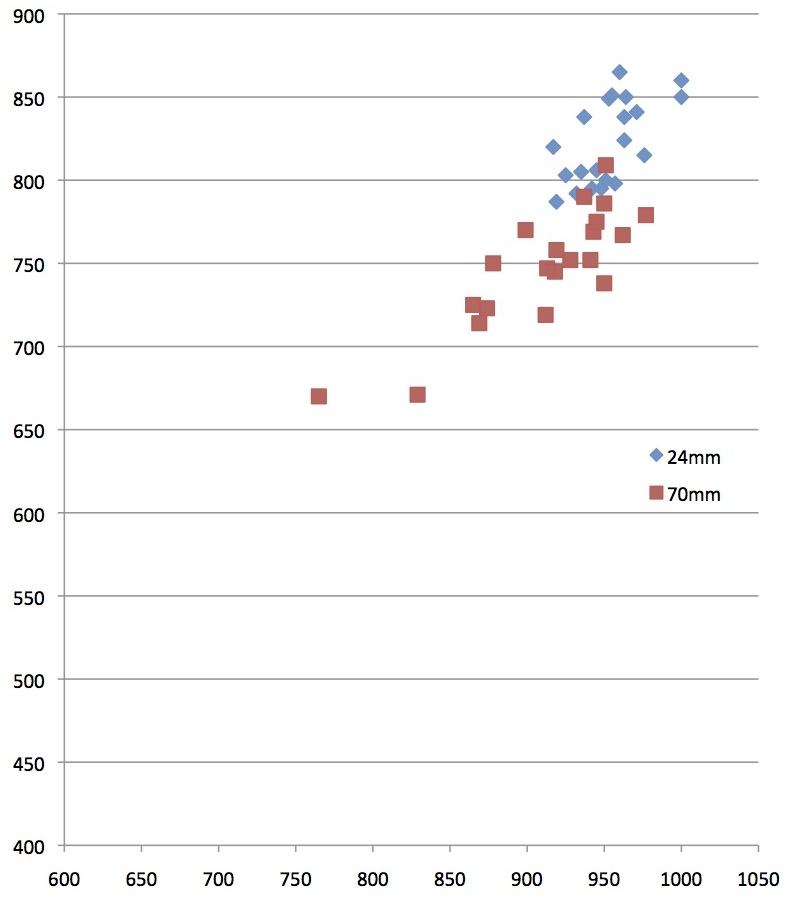
- Center (horizontal) and average (vertical) MTF50
That’s a nice, tight pattern at 24mm, but at 70mm things are a bit more spread out. There are two outliers at 70mm. Further testing on the worst one shows it is clearly decentered. The not-quite-as-bad one seems to be a bit decentered as well. I will note that I took these two values out when I calculated the averages above since I want those to reflect good copies of the lens.
Twenty-two lenses is a pretty small sample to make further comments. I’ll have more to say when we have seen 60 or 70 copies.
Addendum, January 14:
After a head’s up from our friends at SLRgear.com and a couple of other users, who saw lower resolution in their copies at 50mm, we went back and retested a couple of dozen 24-70 f/4 IS at 3 focal lengths (24, 50, 70mm) instead of our usual two. (Most, but not all, zooms have lowest resolution at one extreme or the other, so we focus our testing there.)
We did find that 50mm resolution was slightly lower than 70mm for every copy. The center / weighted average at 50mm for the 24-70 f/4 IS was 875 / 700, compared to 920 / 750 at 70mm. Not a huge drop, but it was consistent. This is a bit surprising, but not a total shock. Some wide angle zooms exhibit similar behavior and the dip in resolution isn’t extreme.
One thing that may be important to those of you who shoot around 50mm a lot, though, is that we also tested the Canon 24-70 f/2.8 Mk II and the Tamron 24-70 f/2.8 VR at 50mm. Both of these lenses were as sharp at 50mm as they were at 70mm, at both f/2.8 and f/4.
Conclusions
Obviously this hasn’t told us a thing about autofocus accuracy, bokeh, or a dozen other things that have to be considered when choosing a lens. Just like you, I’ll be waiting for more complete reviews to tell us about that.
On the basis of this information, though, I’m . . . well, I don’t know what I am. This is a good lens, but I at the price point I’d probably prefer the f/2.8 of the Tamron VC to the new Canon’s f/4. The macro feature is nice and will certainly pull some people towards the Canon.
This is only a sample of 22 copies, but the sample variation at 70mm is a bit bothersome. I don’t feel comfortable making any statements about it, though, until we’ve seen another 40 or 50 copies. This might just be a couple of bad lenses in a small sample.
My bottom line is I sit here thinking the prices need to settle down a bit. If I was considering upgrading to one of these lenses I’d probably hold off a few months and see how the prices change.
Roger Cicala
Lensrentals.com
January, 2013
Author: Roger Cicala
I’m Roger and I am the founder of Lensrentals.com. Hailed as one of the optic nerds here, I enjoy shooting collimated light through 30X microscope objectives in my spare time. When I do take real pictures I like using something different: a Medium format, or Pentax K1, or a Sony RX1R.
-
L.P.O.
-
CarVac
-
webtv
-
Håkon K. Olafsen
-
george
-
Wphotog
-
Joachim / CH
-
Ron
-
GR
-
richard
-
simon
-
NoiseJammer
-
A
-
abi74
-
Ben
-
Ben
-
Howard
-
Ben
-
RBR
-
Ben
-
Aaron
-
Patrice Troost
-
Bruce A.
-
Peter
-
Steve Justad
-
Steven D.

